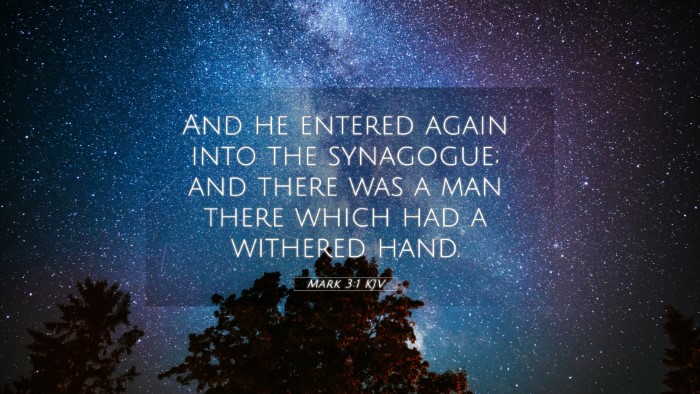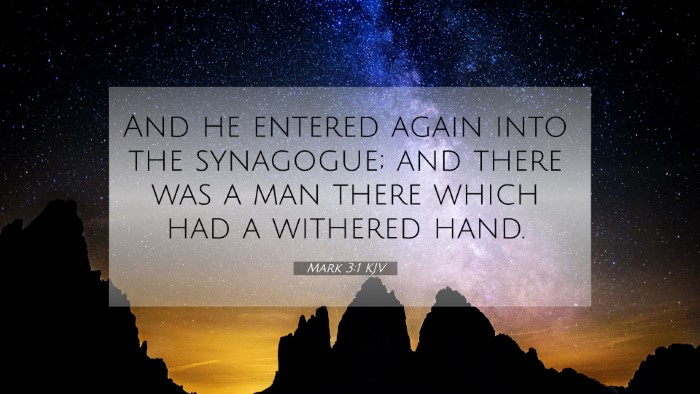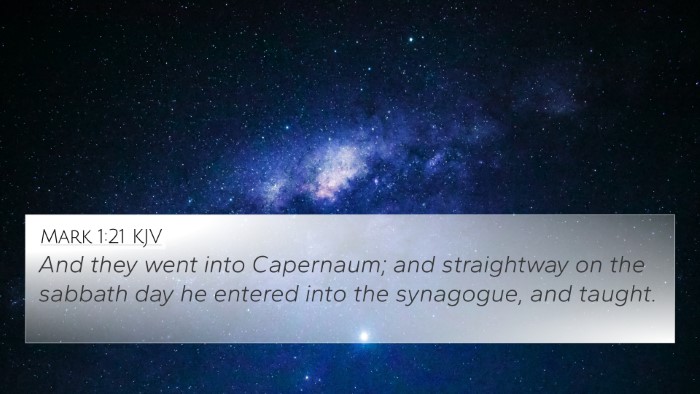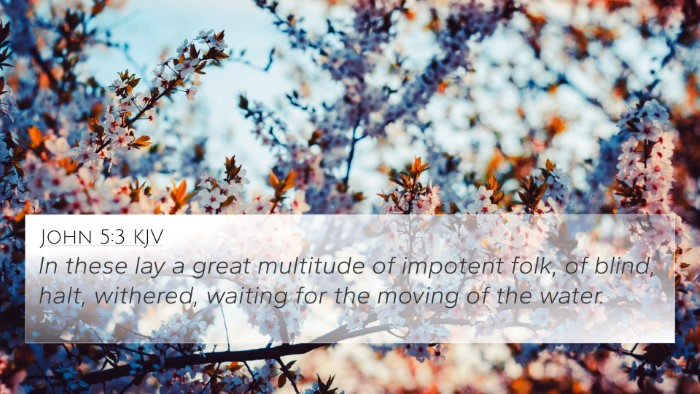Understanding Mark 3:1
Bible Verse: Mark 3:1 (NIV) - "Another time he went into the synagogue, and a man with a shriveled hand was there."
Summary of Mark 3:1
In this verse, the context is set in a synagogue where Jesus demonstrates compassion and authority, marking a pivotal moment in His ministry. The presence of a man with a shriveled hand highlights the theme of healing and the contrast between human need and religious law. Jesus' actions will provoke questions regarding the observance of the Sabbath, setting the stage for deeper theological implications.
Insights from Commentaries
This section synthesizes insights from Matthew Henry, Albert Barnes, and Adam Clarke.
Matthew Henry's Commentary:
Henry emphasizes the importance of the synagogue as a place of worship and the significance of the afflicted man. He notes that Jesus' healing acts are demonstrations of divine compassion and a challenge to the existing religious norms, which often prioritize law over mercy.
Albert Barnes' Commentary:
Barnes provides insights into the social implications of the man’s condition, suggesting that his withered hand symbolizes spiritual and physical impoverishment. He argues that Jesus' intent was not just to heal, but to convey a deeper message about God’s grace and the importance of love over legalism.
Adam Clarke's Commentary:
Clarke offers a detailed analysis of the cultural context, explaining that synagogue gatherings were meant for teaching and prayer. He points out that the man with the shriveled hand would have faced social stigma, and Jesus' act of healing serves as a transformative societal message, breaking taboos to restore dignity.
Connections to Other Scripture
Mark 3:1 connects with several other passages that echo its themes of healing, mercy, and the challenge of religious traditions:
- Matthew 12:10-14: Similar account of healing on the Sabbath where Jesus confronts the Pharisees.
- Luke 6:6-11: Another healing of a man with a withered hand, illustrating Luke's focus on Jesus' compassion.
- Isaiah 61:1: Prophecy about the Messiah, emphasizing bringing good news to the poor and healing the brokenhearted.
- John 5:1-9: The healing at the pool of Bethesda, showcasing Jesus’ authority over the physical and spiritual ailments.
- James 2:13: "Judgment without mercy will be shown to anyone who has not been merciful," relating back to the theme of mercy over legalism.
- Matthew 9:12-13: Jesus states that He desires mercy, not sacrifice, reinforcing the nature of His mission.
- Mark 2:27: Jesus teaches that the Sabbath was made for man, underlining the principle of human need over rigid adherence to law.
- Matthew 8:3: The healing of a leper illustrates Jesus' willingness to touch the untouchable, reflecting the same compassion.
- Luke 13:10-17: Another account of healing a woman on the Sabbath, demonstrating Jesus’ consistent challenge to religious norms.
- Matthew 14:14: Jesus sees the crowds and has compassion on them, continuing the emphasis on His merciful nature.
Thematic Connections and Cross-Referencing
Mark 3:1 can be analyzed through various thematic lenses that further enhance its understanding:
- The Compassion of Christ: Numerous occurrences show how Jesus cares for the marginal and suffering, illustrated in Mark 6:34 and Matthew 20:34.
- Religious Law vs. Mercy: The debate between adhering to rules and demonstrating love is central in Galatians 5:14 and 1 John 3:18.
- The Nature of the Sabbath: The intention behind Sabbath laws is explored in Deuteronomy 5:14 and Exodus 20:8-11.
- Societal Healing: Jesus' miracles often bring not only physical healing but restore dignity, as seen in John 9:1-12.
- Challenge to Religious Authorities: Instances where Jesus confronts the Pharisees illustrate a pattern in the Gospels, such as in Matthew 23:1-36.
- The Role of Faith in Healing: Other healing narratives indicate the importance of faith, referenced in Matthew 9:28-30.
- Human Need and God’s Response: The overarching theme of God responding to human plight can be traced through Psalms 34:18 and Philippians 4:19.
Conclusion
Mark 3:1 invites readers to reflect not only on the miracle of healing but on the deeper theological implications of Jesus’ actions. By analyzing this verse and its connections to other Scripture, we are reminded of the compassionate nature of Christ, the importance of mercy, and the challenge of rigid religious practices. Through cross-referencing, one can appreciate the continuity and richness of the Biblical narrative, discerning the profound truths that echo throughout God's Word.
Further Study and Tools
For deeper study, consider utilizing:
- Bible Concordance: A helpful tool for exploring words and themes across the scripture.
- Bible Cross-Reference Guide: Essential for finding related verses and themes.
- Cross-Reference Bible Study Methods: Techniques for thorough analysis and understanding the relationships between biblical texts.







